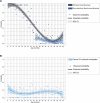The Prevalence of Bowel and Bladder Function During Early Childhood: A Population-Based Study
- PMID: 37098114
- PMCID: PMC10259211
- DOI: 10.1097/MPG.0000000000003804
The Prevalence of Bowel and Bladder Function During Early Childhood: A Population-Based Study
Abstract
Objectives: Our primary aim was to determine bowel and bladder function in children aged 1 month to 7 years in the general Dutch population. Second, we aimed to identify demographic factors associated with the presence of bowel and bladder dysfunction, and their coexistence.
Methods: For this cross-sectional, population-based study, parents/caregivers of children aged from 1 month to 7 years were asked to complete the Early Pediatric Groningen Defecation and Fecal Continence questionnaire. Different parameters of bowel and bladder function were assessed using validated scoring systems such as the Rome IV criteria.
Results: The mean age of the study population (N = 791) was 3.9 ± 2.2 years. The mean age at which parents/caregivers considered their child fully toilet-trained was 5.1 ± 1.5 years. Prevalence of fecal incontinence among toilet-trained children was 12%. Overall prevalence of constipation was 14%, with a constant probability and severity at all ages. We found significant associations between fecal incontinence and constipation [odds ratio (OR) = 3.88, 95% CI: 2.06-7.30], fecal incontinence and urinary incontinence (OR = 5.26, 95% CI: 2.78-9.98), and constipation and urinary incontinence (OR = 2.06, 95% CI: 1.24-3.42).
Conclusions: Even though most children are fully toilet-trained at 5 years, fecal incontinence is common. Constipation appears to be common in infants, toddlers, and older children. Fecal incontinence and constipation frequently coexist and are often accompanied by urinary incontinence. Increased awareness of bowel and bladder dysfunction in infants, toddlers, and young children is required to prevent these problems from continuing at older ages.
Copyright © 2023 The Author(s). Published by Wolters Kluwer on behalf of European Society for Pediatric Gastroenterology, Hepatology, and Nutrition and North American Society for Pediatric Gastroenterology, Hepatology, and Nutrition.
Conflict of interest statement
The authors report no conflicts of interest.
Figures




Similar articles
-
Prevalence of functional defecation disorders in European children: A systematic review and meta-analysis.J Pediatr Gastroenterol Nutr. 2025 Apr;80(4):580-597. doi: 10.1002/jpn3.12437. Epub 2025 Jan 8. J Pediatr Gastroenterol Nutr. 2025. PMID: 39775925 Free PMC article.
-
Development and validation of the Early Pediatric Groningen Defecation and Fecal Continence questionnaire.Eur J Pediatr. 2023 Feb;182(2):615-623. doi: 10.1007/s00431-022-04714-2. Epub 2022 Nov 21. Eur J Pediatr. 2023. PMID: 36414869 Free PMC article.
-
Functional defecation disorders in children with lower urinary tract symptoms.J Urol. 2013 May;189(5):1886-91. doi: 10.1016/j.juro.2012.10.064. Epub 2012 Oct 30. J Urol. 2013. PMID: 23123369
-
On the prevalence of constipation and fecal incontinence, and their co-occurrence, in the Netherlands.Int J Colorectal Dis. 2017 Apr;32(4):475-483. doi: 10.1007/s00384-016-2722-3. Epub 2016 Dec 2. Int J Colorectal Dis. 2017. PMID: 27913883 Free PMC article.
-
Coexistence of constipation and incontinence in children and adults.Best Pract Res Clin Gastroenterol. 2011 Feb;25(1):29-41. doi: 10.1016/j.bpg.2010.12.002. Best Pract Res Clin Gastroenterol. 2011. PMID: 21382577 Free PMC article. Review.
Cited by
-
Prevalence of functional defecation disorders in European children: A systematic review and meta-analysis.J Pediatr Gastroenterol Nutr. 2025 Apr;80(4):580-597. doi: 10.1002/jpn3.12437. Epub 2025 Jan 8. J Pediatr Gastroenterol Nutr. 2025. PMID: 39775925 Free PMC article.
References
-
- Koppen IJN, Vriesman MH, Saps M, et al. . Prevalence of functional defecation disorders in children: a systematic review and meta-analysis. J Pediatr. 2018;198:121–30. - PubMed
-
- Hyams JS, Di Lorenzo C, Saps M, Shulman RJ, Staiano A, van Tilburg M. Childhood functional gastrointestinal disorders: child/adolescent. Gastroenterology. 2016;150:1456–68.e2. - PubMed
-
- Kovacic K, Sood MR, Mugie S, et al. . A multicenter study on childhood constipation and fecal incontinence: effects on quality of life. J Pediatr. 2015;166:1482–7.e1. - PubMed
-
- Vriesman MH, Rajindrajith S, Koppen IJN, et al. . Quality of life in children with functional constipation: a systematic review and meta-analysis. J Pediatr. 2019;214:141–50. - PubMed
MeSH terms
LinkOut - more resources
Full Text Sources
Medical

